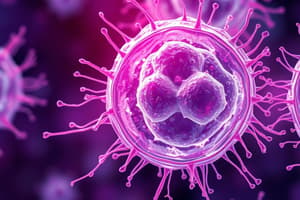Podcast
Questions and Answers
What is the purpose of cell separation?
What is the purpose of cell separation?
- To study the unique characteristics and functions of individual cells (correct)
- To prevent contamination in cell samples
- To create complex mixtures for analysis
- To develop new treatments for diseases
What techniques are involved in preparing samples for cell separation?
What techniques are involved in preparing samples for cell separation?
- Fluorescence-activated cell sorting (FACS), magnetic-activated cell sorting (MACS), and density gradient centrifugation
- DNA sequencing, protein synthesis, and organelle extraction
- Electron microscopy, immunohistochemistry, and immunofluorescence
- Cell culture, tissue dissociation, and staining (correct)
What is the purpose of identifying specific cell components after cell separation?
What is the purpose of identifying specific cell components after cell separation?
- To study cellular behavior
- To separate cells from complex mixtures
- To identify proteins, DNA, and organelles (correct)
- To develop new cell separation methods
What are examples of cell separation methods?
What are examples of cell separation methods?
What insights can scientists gain by isolating cells?
What insights can scientists gain by isolating cells?
What can be observed using light microscopy?
What can be observed using light microscopy?
What is the primary advantage of electron microscopy over light microscopy?
What is the primary advantage of electron microscopy over light microscopy?
What is the principle of immunofluorescence?
What is the principle of immunofluorescence?
What is the process of immunofluorescence?
What is the process of immunofluorescence?
What can electron microscopy visualize that light microscopy cannot?
What can electron microscopy visualize that light microscopy cannot?
Flashcards are hidden until you start studying
Study Notes
Cell Separation
- Cell separation is a crucial step in understanding cellular structure and function, as it enables the study of individual cells or specific cell populations.
- Separation of cells allows for the analysis of specific cell types, which is essential for understanding cellular behavior, development, and disease.
Sample Preparation
- Preparing samples for cell separation involves techniques such as:
- Cell dissociation to break down tissue into individual cells
- Cell filtering to remove debris and isolate specific cell types
- Cell centrifugation to separate cells based on density and size
Identifying Cell Components
- Identifying specific cell components after cell separation is important for understanding cellular function and behavior.
- This involves techniques such as:
- Immunostaining to label specific proteins or structures
- Fluorescence microscopy to visualize labeled components
- Electron microscopy to examine ultrastructural details
Cell Separation Methods
- Examples of cell separation methods include:
- Density gradient centrifugation
- Magnetic-activated cell sorting (MACS)
- Fluorescence-activated cell sorting (FACS)
Insights from Isolating Cells
- Isolating cells allows scientists to gain insights into:
- Cellular behavior and function
- Cellular development and differentiation
- Cellular response to disease or environmental stimuli
Light Microscopy
- Light microscopy can be used to observe:
- Cellular morphology and structure
- Cellular organelles and inclusions
- Cellular interactions and dynamics
Electron Microscopy
- The primary advantage of electron microscopy over light microscopy is its:
- Higher resolution and magnification capabilities
- Ability to visualize ultrastructural details
- Electron microscopy can visualize:
- Cellular membranes and organelles
- Protein structures and complexes
- Viral and bacterial structures
Immunofluorescence
- The principle of immunofluorescence is the use of antibodies to specifically label and visualize target molecules or structures.
- The process of immunofluorescence involves:
- Antibody binding to target molecules
- Fluorophore conjugation to the antibody
- Visualization of the labeled molecule using fluorescence microscopy
Studying That Suits You
Use AI to generate personalized quizzes and flashcards to suit your learning preferences.



